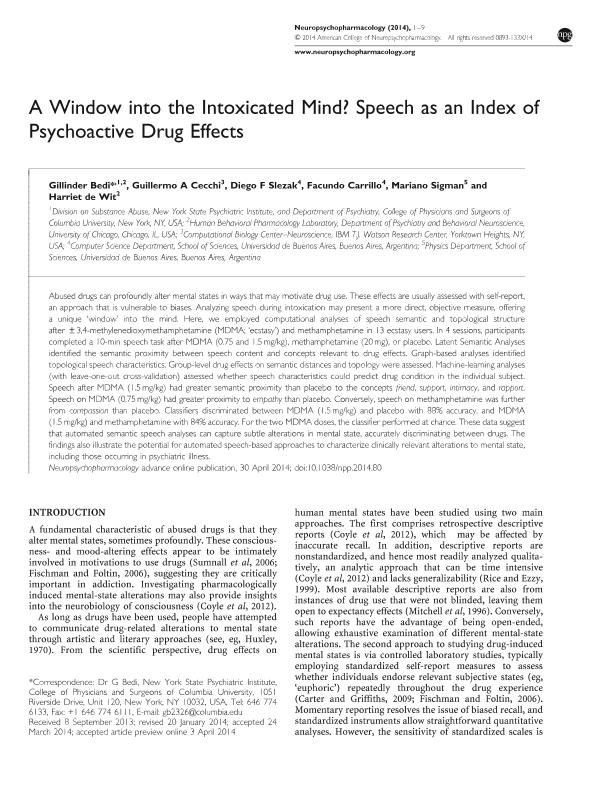Mostrar el registro sencillo del ítem
dc.contributor.author
Bedi, Gillinder
dc.contributor.author
Cecchi, Guillermo Alberto

dc.contributor.author
Fernandez Slezak, Diego

dc.contributor.author
Carrillo, Facundo

dc.contributor.author
Sigman, Mariano

dc.contributor.author
de Wit, Harriet
dc.date.available
2017-12-01T21:22:39Z
dc.date.issued
2014-04
dc.identifier.citation
Bedi, Gillinder; Cecchi, Guillermo Alberto; Fernandez Slezak, Diego; Carrillo, Facundo; Sigman, Mariano; et al.; A Window into the Intoxicated Mind? : speech as an Index of Psychoactive Drug Effects; Nature Publishing Group; Neuropsychopharmacology; 39; 10; 4-2014; 2340-2348
dc.identifier.issn
0893-133X
dc.identifier.uri
http://hdl.handle.net/11336/29509
dc.description.abstract
Abused drugs can profoundly alter mental states in ways that may motivate drug use. These effects are usually assessed with self-report, an approach that is vulnerable to biases. Analyzing speech during intoxication may present a more direct, objective measure, offering a unique ‘window’ into the mind. Here, we employed computational analyses of speech semantic and topological structure after ±3,4-methylenedioxymethamphetamine (MDMA; ‘ecstasy’) and methamphetamine in 13 ecstasy users. In 4 sessions, participants completed a 10-min speech task after MDMA (0.75 and 1.5 mg/kg), methamphetamine (20 mg), or placebo. Latent Semantic Analyses identified the semantic proximity between speech content and concepts relevant to drug effects. Graph-based analyses identified topological speech characteristics. Group-level drug effects on semantic distances and topology were assessed. Machine-learning analyses (with leave-one-out cross-validation) assessed whether speech characteristics could predict drug condition in the individual subject. Speech after MDMA (1.5 mg/kg) had greater semantic proximity than placebo to the concepts friend, support, intimacy, and rapport. Speech on MDMA (0.75 mg/kg) had greater proximity to empathy than placebo. Conversely, speech on methamphetamine was further from compassion than placebo. Classifiers discriminated between MDMA (1.5 mg/kg) and placebo with 88% accuracy, and MDMA (1.5 mg/kg) and methamphetamine with 84% accuracy. For the two MDMA doses, the classifier performed at chance. These data suggest that automated semantic speech analyses can capture subtle alterations in mental state, accurately discriminating between drugs. The findings also illustrate the potential for automated speech-based approaches to characterize clinically relevant alterations to mental state, including those occurring in psychiatric illness.
dc.format
application/pdf
dc.language.iso
eng
dc.publisher
Nature Publishing Group

dc.rights
info:eu-repo/semantics/openAccess
dc.rights.uri
https://creativecommons.org/licenses/by-nc-sa/2.5/ar/
dc.subject
Ecstasy
dc.subject
Mdma
dc.subject
Methamphetamine
dc.subject
Speech
dc.subject
Semantic Analyses
dc.subject
Machine Learning
dc.subject.classification
Otras Ciencias Biológicas

dc.subject.classification
Ciencias Biológicas

dc.subject.classification
CIENCIAS NATURALES Y EXACTAS

dc.title
A Window into the Intoxicated Mind? : speech as an Index of Psychoactive Drug Effects
dc.type
info:eu-repo/semantics/article
dc.type
info:ar-repo/semantics/artículo
dc.type
info:eu-repo/semantics/publishedVersion
dc.date.updated
2017-06-09T14:19:29Z
dc.journal.volume
39
dc.journal.number
10
dc.journal.pagination
2340-2348
dc.journal.pais
Reino Unido

dc.description.fil
Fil: Bedi, Gillinder. Columbia University; Estados Unidos
dc.description.fil
Fil: Cecchi, Guillermo Alberto. Ibm Research. Thomas J. Watson Research Center; Estados Unidos. Consejo Nacional de Investigaciones Científicas y Técnicas; Argentina
dc.description.fil
Fil: Fernandez Slezak, Diego. Universidad de Buenos Aires. Facultad de Ciencias Exactas y Naturales. Departamento de Computación; Argentina. Consejo Nacional de Investigaciones Científicas y Técnicas; Argentina
dc.description.fil
Fil: Carrillo, Facundo. Universidad de Buenos Aires. Facultad de Ciencias Exactas y Naturales. Departamento de Computación; Argentina. Consejo Nacional de Investigaciones Científicas y Técnicas; Argentina
dc.description.fil
Fil: Sigman, Mariano. Universidad de Buenos Aires. Facultad de Ciencias Exactas y Naturales. Departamento de Física; Argentina. Consejo Nacional de Investigaciones Científicas y Técnicas; Argentina
dc.description.fil
Fil: de Wit, Harriet. Columbia University; Estados Unidos
dc.journal.title
Neuropsychopharmacology

dc.relation.alternativeid
info:eu-repo/semantics/altIdentifier/doi/http://dx.doi.org/10.1038/npp.2014.80
dc.relation.alternativeid
info:eu-repo/semantics/altIdentifier/url/https://www.nature.com/articles/npp201480
dc.relation.alternativeid
info:eu-repo/semantics/altIdentifier/url/https://www.ncbi.nlm.nih.gov/pmc/articles/PMC4138742/
Archivos asociados
